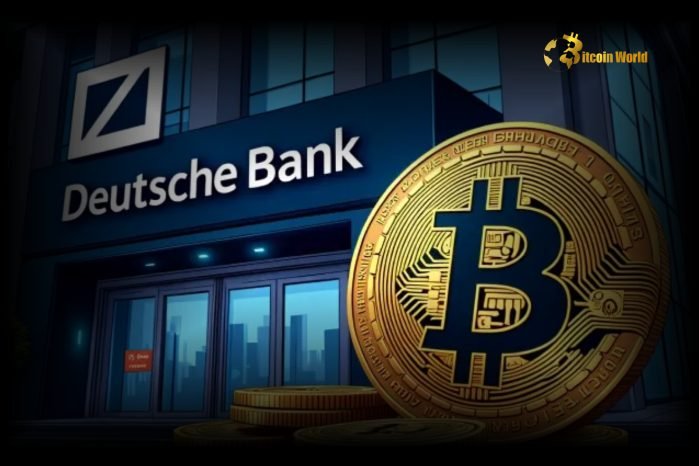Deutsche Bank, Germany’s largest commercial bank, has released a report predicting a bullish outlook for Bitcoin (BTC) in 2025, according to CoinDesk. The bank attributes its optimism to several factors, including a favorable regulatory environment under U.S. President Donald Trump, rising institutional adoption, and the prospect of a looser Federal Reserve monetary policy.
These conditions, combined with increasing clarity about strategic Bitcoin reserves, are expected to drive Bitcoin’s growth, cementing its position as a key asset in the global financial landscape.
To learn more about the innovative startups shaping the future of the crypto industry, explore our article on the latest news, where we delve into the most promising ventures and their potential.
Key Factors Behind Deutsche Bank’s Bitcoin Forecast
- Favorable U.S. Regulatory Environment
- President Trump’s administration has signaled support for cryptocurrencies, creating a regulatory framework conducive to Bitcoin adoption.
- The approval of spot Bitcoin ETFs and the push for a national Bitcoin reserve further underscore the administration’s crypto-friendly stance.
- Institutional Adoption
- Large financial institutions, pension funds, and corporations are increasingly incorporating Bitcoin into their portfolios as a hedge against inflation and currency devaluation.
- The bank cites this trend as a major driver for Bitcoin’s long-term price appreciation.
- Federal Reserve Monetary Policy
- Expectations of a looser monetary policy by the Federal Reserve in response to economic conditions could increase liquidity in the market, benefiting Bitcoin as an alternative asset.
- Strategic Bitcoin Reserve Formation
- Discussions about forming strategic Bitcoin reserves by nations and institutions are expected to drive demand further.
Why Bitcoin is Poised for Growth
Deutsche Bank’s report highlights Bitcoin’s unique position as a digital asset:
- Store of Value: Bitcoin’s fixed supply of 21 million coins enhances its appeal as “digital gold.”
- Global Hedge: Its decentralized nature provides a hedge against geopolitical risks and fiat currency instability.
- Mainstream Adoption: As regulatory clarity improves, Bitcoin is becoming increasingly accessible to both institutional and retail investors.
Bitcoin Price Predictions for 2025
While the report does not specify a price target, Deutsche Bank’s bullish outlook aligns with other institutional forecasts:
- Standard Chartered predicts Bitcoin could reach $200,000 by 2025.
- Analysts expect Bitcoin’s value to be driven by increasing adoption, reduced volatility, and growing integration into traditional finance.
Challenges to Consider
Despite the positive outlook, the report also acknowledges potential risks:
- Regulatory Uncertainty
- Although the U.S. regulatory environment has improved, inconsistent policies globally could pose challenges.
- Market Volatility
- Bitcoin remains a highly volatile asset, which could deter risk-averse investors.
- Competition from Altcoins
- The emergence of alternative cryptocurrencies with advanced use cases could impact Bitcoin’s dominance.
How Institutional Adoption is Changing the Bitcoin Market
The report underscores the growing role of institutions in shaping Bitcoin’s trajectory:
- Increased Liquidity
- Institutional participation enhances liquidity, reducing price manipulation and volatility.
- Mainstream Credibility
- Institutional involvement lends credibility to Bitcoin, attracting a wider audience.
- Product Innovation
- The introduction of Bitcoin ETFs and other financial products has made Bitcoin more accessible to traditional investors.
Conclusion
Deutsche Bank’s prediction of a bullish Bitcoin outlook for 2025 underscores the growing convergence between traditional finance and cryptocurrency. With favorable U.S. regulations, increasing institutional adoption, and accommodative monetary policies, Bitcoin is well-positioned for significant growth in the coming years.
However, investors should remain mindful of potential risks, including regulatory challenges and market volatility. For those looking to capitalize on Bitcoin’s potential, the next few years could represent a pivotal moment in the cryptocurrency’s journey toward mainstream adoption.
To learn more about the innovative startups shaping the future of the crypto industry, explore our article on the latest news, where we delve into the most promising ventures and their potential.
FAQs
What does Deutsche Bank predict for Bitcoin in 2025?
Deutsche Bank forecasts a bullish outlook for Bitcoin in 2025, driven by favorable U.S. regulations, institutional adoption, and looser Federal Reserve policies.
Why is the regulatory environment important for Bitcoin’s growth?
A supportive regulatory framework ensures clarity and legitimacy, encouraging institutional and retail investors to participate in the Bitcoin market.
How does institutional adoption affect Bitcoin’s price?
Institutional adoption increases liquidity, reduces volatility, and lends credibility to Bitcoin, driving long-term price appreciation.
What risks could impact Bitcoin’s growth?
Risks include regulatory uncertainty, market volatility, and competition from alternative cryptocurrencies.
What role does the Federal Reserve play in Bitcoin’s outlook?
A looser monetary policy by the Federal Reserve could increase market liquidity, boosting demand for Bitcoin as a hedge against inflation.
How is Bitcoin becoming more accessible to investors?
The approval of spot Bitcoin ETFs and increased institutional interest have made Bitcoin more accessible to traditional and retail investors.
To learn more about the innovative startups shaping the future of the crypto industry, explore our article on latest news, where we delve into the most promising ventures and their potential to disrupt traditional industries.






